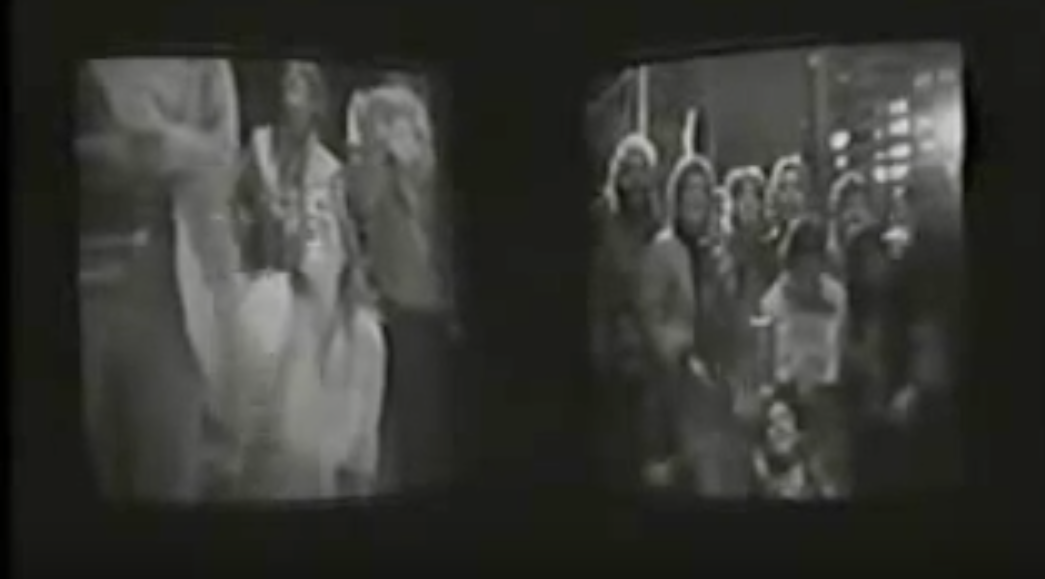Collective Narrative
“the collective narrative is a sharing and open exchange of conversation, ideas, information, and media that leads to a synthesis of voices: forming a common thread among peers.”
-Randall Packer in Collective Narrative in Open Source Studio
With the open source system, narratives now have the flexibility and ability to be fluid in terms of content and structure. The possibilities of how a narrative is formed – how it will start, continue and maybe end, has been widen. In this essay, we will be looking at Hole in Space (1980) by Kit Galloway and Sherrie Rabinowitz as an example of collective narrative.
What is it?
Hole in Space is a work by Kit Galloway and Sherrie Rabinowitz that was done in 1980. It consist of a projection screen situated at Lincoln Center for the Performing Arts at New York City and The Broadway Department Store at the open air Shopping Center in Century City, Los Angeles. [i]
On each screen, a live stream of the other location is being projected for 3 consecutive evenings. On the first evening, people just discover and interact with it. On the second evening, there were more people engaged in the work from people spreading the word and news coverage about it. On the last night, families from a distance came down to the place to communicate with family members that were across the coast and had little chance to meet one another. [ii]
Hole in Space – a Collective Narrative
The social interaction between the people of the two separate spaces enabled the narrative to be constructed, with every moment being unique to that point of time, since no interaction is the same at any point. Along with connecting with the separate spaces, it goes together with the idea of what Galloway and Rabinowitz wanted. To have
“people from varied creative and cultural backgrounds could help create a new environment in which they would collaborate on an international scale.”
-Kit Galloway and Sherrie Rabinowitz in “Welcome to ‘Electronic Cafe International’: A Nice Place for Hot Coffee, Iced Tea, & Virtual Space” (1992)
References:
[i] Galloway, Kit; Rabiniwitz, Sherrie, Hole in Space
[ii] Galloway, Kit; Rabiniwitz, Sherrie, “Welcome to ‘Electronic Cafe International’: A Nice Place for Hot Coffee, Iced Tea, & Virtual Space” (1992)


There was something magical about large video screens in the 1980s, as they were a novelty and had the power to draw people together. Remember that we were still using tiny CRT TVs in 1980, and video was touted as the panacea or magic pill for work and school, as seen here:
Coincidentally, the first large-scale LED display system pioneered by Mitsubishi Electric also appeared in the same year at Hole in Space, at Dodger stadium, Los Angeles, during the 1980 Major League Baseball All-Star Game just four months earlier. These screens were mounted high up and away from spectators. So imagine the excitement of seeing live life size action on a large screen right in front of the audience for the very first time.
Erratum:
“… in the same year AS Hole in Space…”
Hi Nat, I agree that this is a time-based artwork, where every moment is unique to that specific timing. I personally feel that the beauty of this work is in seeing the human re-connect with each other, despite it being through the seen image. In today’s world perhaps, we might be starting to take these technologies for granted.
Ps. (interesting side note):
On doing some background research, it would seem that the production of video conferencing commercially came out only in 1982, 2 years after this art piece.
Cool.
Fascinating. This is something I could use for my literature review. Thanks.
Excellent discussion! Nat, I like your comment about the spontaneity of the work, how no two moments are alike, and how it couldn’t even have been planned in terms of exactly what would take place. When you describe the unfolding narrative of the three evenings, it is worth mentioning that the artists had no certainty as to what would happen. Even they were surprised!